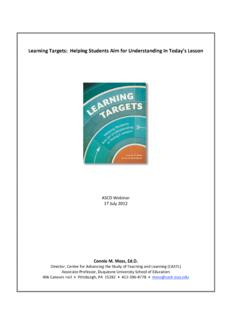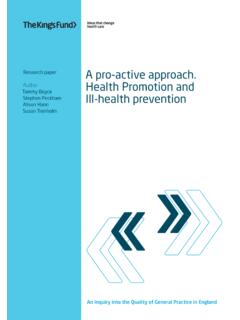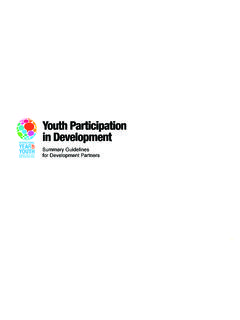Transcription of WHOLE SCHOOL WHOLE COMMUNITY WHOLE CHILD - ASCD
1 WHOLE SCHOOLWHOLE COMMUNITYWHOLE CHILDA Collaborative approach to Learning and Health1703 North Beauregard St. Alexandria, VA 22311-1714 USA Phone: 1-800-933-2723 or 1-703-578-9600 Fax: 1-703-575-5400 E-mail: Gene R. Carter, Executive Director; Judy Seltz, Deputy Executive Director, Chief Constituent Services Officer; Sean Slade, Director, WHOLE CHILD Programs; Theresa Lewallen, Senior Director, Constituent Programs; Klea Scharberg, WHOLE CHILD Programs Specialist; Kristen Pekarek, Project Coordinator; Gary Bloom, Senior Creator Director; Reece Qui ones, Art Director; Lindsey Heyl Smith, Graphic Designer; Greer Wymond, Graphic Designer; Mary Beth Nielsen, Manager, Editorial Services; Mike Kalyan, Manager, Production Services; Kyle Steichen, Production Specialist 2014 by ASCD.
2 All rights reserved. Printed in the United States of America. ABOUT ASCD ASCD is a global COMMUNITY dedicated to excellence in learning, teaching, and leading. Comprising 140,000 mem-bers superintendents, principals, teachers, and advocates from more than 138 countries the ASCD COMMUNITY also includes 56 affiliate organizations. ASCD s innovative solutions promote the success of each CHILD . To learn more about how ASCD supports educators as they learn, teach, and lead, visit ABOUT ASCD S WHOLE CHILD INITIATIVE Launched in 2007, ASCD s WHOLE CHILD Initiative is an effort to change the conversation about education from a focus on narrowly defined academic achievement to one that promotes the long-term development and success of children.
3 Through the initiative, ASCD helps educators, families, COMMUNITY members, and policymakers move from a vision about educating the WHOLE CHILD to sustainable, collaborative action. ASCD is joined in this effort by WHOLE CHILD Partner organizations representing the education, arts, health , policy, and COMMUNITY sectors. Learn more at ABOUT THE CENTERS FOR DISEASE CONTROL AND PREVENTION CDC works 24/7 to protect America from health , safety, and security threats, both foreign and in the Whether diseases start at home or abroad, are chronic or acute, curable or preventable, human error or deliberate attack, CDC fights disease and supports communities and citizens to do the same. As the nation s health protection agency, CDC saves lives and protects people from health threats.
4 To accomplish its mission, CDC conducts critical science and pro-vides health information that protects our nation against expensive and dangerous health threats, and responds when these arise. Learn more at The mark CDC is owned by the Dept. of health and Human Services and is used with permission. Use of this logo is not an endorsement by HHS or CDC of any particular product, service, or Collaborative approach to Learning and Health03 Why We Need a Collaborative approach to Learning and Health05 The Need for a New Model06 Expanded Components09 Coordinating Policy, Process, and Practice09 WHOLE SCHOOL , WHOLE COMMUNITY , WHOLE Child10 References12 Core and Consultation Groups13 The WHOLE SCHOOL , WHOLE COMMUNITY , WHOLE CHILD ModelWHOLE SCHOOLWHOLE COMMUNITYWHOLE CHILDHEALTH AND EDUCATION AFFECT INDIVIDUALS, SOCIETY, AND THE ECONOMY AND, AS SUCH, MUST WORK TOGETHER WHENEVER POSSIBLE.
5 SCHOOLS ARE A PERFECT SETTING FOR THIS attend SCHOOL . At the same time, integrat-ing health services and programs more deeply into the day-to-day life of schools and students represents an untapped tool for raising academic achievement and improving short, learning and health are interrelated. Studies demonstrate that when children s basic nutritional and fitness needs are met, they attain higher achievement 14 Similarly, the use of SCHOOL -based and SCHOOL -linked health centers ensuring access to needed physical, mental, and oral health care improves attendance,15 behavior,16 21 and 25 The development of connected and supportive SCHOOL environments benefits teaching and learning, engages students, and enhances positive For the purposes of this document, academic achievement is defined as: 1.
6 Academic performance (class grades, standardized tests, and graduation rates); 2. Education behavior (attendance, dropout rates, and behavioral problems at SCHOOL ); and 3. Students cognitive skills and attitudes (concentration, memory, and mood).Source: Centers for Disease Control and Prevention. The association between schoolbased physical activity, including physical education, and academic performance. Atlanta (GA): US Department of health and Human Services; and well-being have, for too long, been put into silos separated both logistically and philo-sophically from education and learning. In his meta-analysis Healthier Students Are Bet-ter Learners,1 Charles Basch called a renewed focus on health the missing link in SCHOOL reforms to close the achievement matter how well teachers are prepared to teach, no matter what accountability mea-sures are put in place, no matter what gov-erning structures are established for schools, educational progress will be profoundly lim-ited if students are not motivated and able to in the same publication Basch stated,Though rhetorical support is increasing.
7 SCHOOL health is currently not a central part of the fundamental mission of schools in Amer-ica nor has it been well integrated into the broader national strategy to reduce the gaps in educational opportunity and and education affect individuals, society, and the economy and, as such, must work together whenever possible. Schools are a perfect set-ting for this collaboration. Schools are one of the most efficient systems for reaching children and youth to provide health services and programs, as approximately 95 percent of all children and WHY WE NEED A COLLABORATIVE approach TO LEARNING AND HEALTH3It is time to truly align the sectors and place the CHILD at the center. Both public health and education serve the same students, often in the same settings.
8 We must do more to work together and collaborate. WAYNE H. GILES, DIRECTOR, DIVISION OF POPULATION health , NATIONAL CENTER FOR CHRONIC DISEASE PREVENTION AND health PROMOTION, CDC4whole CHILD . Policy, practice, and resources must be aligned to support not only academic learning for each CHILD , but also the experiences that encourage development of a WHOLE CHILD one who is knowledgeable, healthy, motivated, and calls for collaboration have come from the health sector, including the U. S. Centers for Disease Control and Prevention (CDC).In sum, if American schools do not coordinate and modernize their SCHOOL health programs as a critical part of educational reform, our children will continue to benefit at the mar-gins from a wide disarray of otherwise unre-lated, if not underdeveloped, efforts to improve interdependent education, health , and social outcomes.
9 And, we will forfeit one of the most appropriate and powerful means available to improve student traditional coordinated SCHOOL health (CSH) approach has been a mainstay of SCHOOL health in the United States since 1987. Promulgated by the CDC, the CSH approach has provided a suc-cinct and distinct framework for organizing a com-prehensive approach to SCHOOL health . In addition to the CDC, many national health and education organizations have supported the CSH approach . However, it has been viewed by educators as primarily a health initiative focused only on health outcomes and has consequently gained limited traction across the education sector at the SCHOOL outcomes. The development of a positive social and emotional climate increases academic achievement, reduces stress, and improves positive attitudes toward self and , 27 In turn, academic achievement is an excellent indicator for the overall well-being of youth and a primary predictor and determinant of adult health 29 Individuals with more edu-cation are likely to live longer; experience better health outcomes.
10 And practice health -promoting behaviors such as exercising regularly, refrain-ing from smoking, and obtaining timely health care check-ups and 34 These posi-tive outcomes are why many of the nation s lead-ing educational organizations recognize the close relationship between health35 37 and education, as well as the need to foster health and well-being within the educational environment for all 41 THE NEED FOR A NEW MODELIn 2007, ASCD called for an acknowledgement of the interdependent nature of health and call on communities educators, parents, businesses, health and social service providers, arts professionals, recreation leaders, and poli-cymakers at all levels to forge a new compact with our young people to ensure their WHOLE and healthy development.






